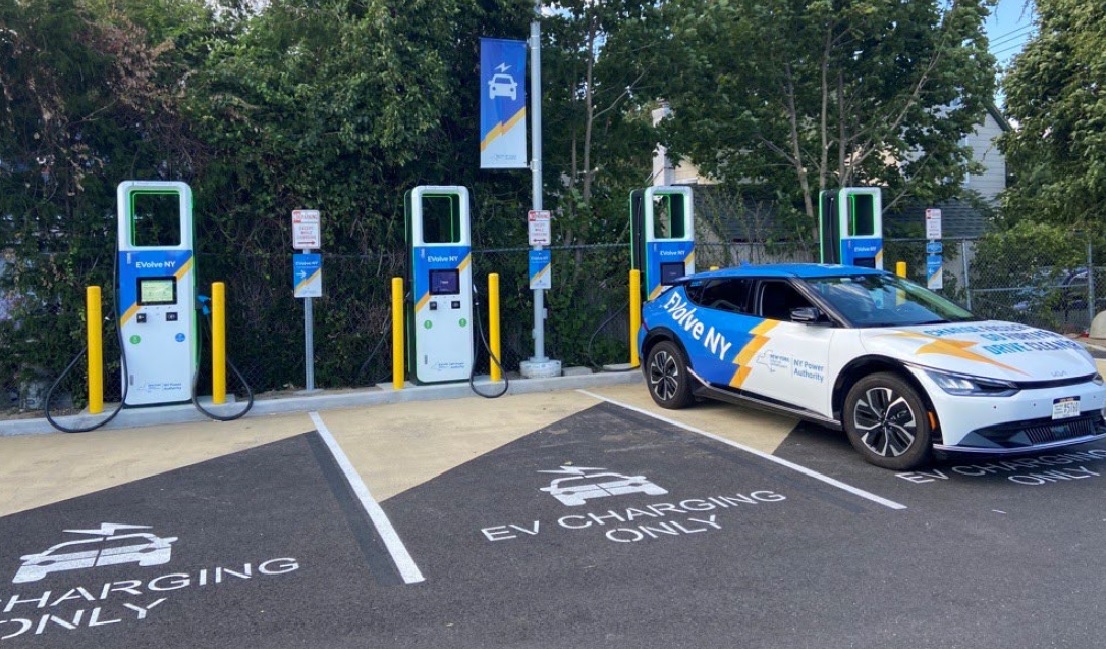President Biden’s goals of building out a national network of 500,000 EV chargers got a boost with the announced funding to accelerate the creation of zero-emission vehicle (ZEV) corridors that expand the nation’s electric vehicle (EV) charging infrastructure.
The Department of Energy (DOE) has awarded $7.4 million to seven projects to develop medium- and heavy-duty electric vehicle (EV) charging and hydrogen corridor infrastructure plans that will benefit millions of drivers across 23 states.
“A clean transportation sector requires vast investments across the entire industry, including to decarbonize the trucks that move our goods and building more charging ports to get those trucks from coast to coast,” said U.S. Secretary of Energy Jennifer M. Granholm. “President Biden’s historic clean energy laws are making it possible for us to get more EVs on the road by expanding charging infrastructure into underserved communities, while reducing range and cost anxiety among drivers who want to go electric.”
Freight corridor focus
The projects will advance the President’s decarbonization goals by accelerating the deployment of medium- and heavy-duty EV charging and refueling infrastructure to reduce emissions from freight corridors and the depots, ports, and other facilities those corridors service. The freight corridors include those serving Northern and Southern California, the Eastern Seaboard, the Northeast, Southwest, and much of the Midwest.
Selected projects support DOE’s Justice40 priorities by demonstrating the impacts and benefits of these freight corridors plans on underserved communities. The projects would also help improve air quality in underserved areas of major American cities, including New York, Los Angeles, Houston, Chicago, San Francisco, Oakland, and Salt Lake City.
The selected projects are:
- CALSTART: East Coast Commercial ZEV Corridor. This project will launch an intensive strategic planning effort to spur the deployment of commercial medium- and heavy-duty (MHD) zero-emission vehicle (ZEV) infrastructure through the development of an East Coast Commercial ZEV Corridor along the I-95 freight corridor from Georgia to New Jersey.
- Cummins Inc.: MD-HD ZEV Infrastructure Planning with Focus on I-80 Midwest Corridor. This project will develop an extensive two-phase MD-HD EV Charging and H2 Fueling Plan for the Midwest I-80 corridor serving Indiana, Illinois, and Ohio, to support 30% of the MD-HD fleet using ZEV technologies by 2035.
- GTI Energy: Houston to Los Angeles (H2LA)–I-10 Hydrogen Corridor Project. This project will develop a flexible and scalable blueprint plan for an investment-ready hydrogen fueling and heavy-duty freight truck network from Houston to LA (H2LA) along I-10, including the Texas Triangle region, and in the process develop methodology for future corridor plans across the country.
- Los Angeles Cleantech Incubator: First to Last Mile: Creating an Integrated Goods Movement Charging Network around the I-710 Corridor. This project will create a plan for innovative infrastructure solutions at industrial facilities and commercial zones along critical freight arteries feeding into Southern California’s I-710 freeway. The project will explore how private sector fleets can establish an integrated network that leverages existing industrial and commercial real estate assets while providing greatest benefit to municipalities and communities.
- National Grid: Northeast Electric Highways Study. This project will forecast electric charging demand at traffic stops on freight corridors across Maine, Massachusetts, New Hampshire, Vermont, Rhode Island, Connecticut, New York, Pennsylvania, and New Jersey to help inform a blueprint for future large-scale, least-cost deployment of commercial EV charging and serve as an exemplar for other regions.
- Rocky Mountain Institute: San Francisco and Bay Area Regional Medium-and Heavy-Duty Electrification Roadmap. This project will create a roadmap for charging infrastructure to support the full electrification of three key trucking market segments – drayage, regional haul, and long-haul – in the Bay Area of California.
- Utah State University: Wasatch Front Multi-Modal Corridor Electrification Plan – Greater Salt Lake City Region. This project will develop a community, state and industry supported action plan that will improve air quality in the underserved communities most impacted by high-density medium- and heavy-duty traffic in the greater Salt Lake City region.
Charging infrastructure
The Joint Office of Energy and Transportation issued a funding Notice of Intent to address challenges to achieving an equitable clean transportation future. The funding is expected to expand charging infrastructure in underserved communities.
Anticipated topic areas include:
- Enhancing EV charging resiliency
- Community-driven EV charging deployment benefits planning, implementation, and tracking in underserved communities
- Workforce development
- Increasing commercial capacity for testing and certification of high-power EV chargers
- Validating high-power EV charger real-world performance and reliability
These announcements will help companies implement the requirements included in the recently published minimum standards developed by DOT with DOE input for federally funded EV infrastructure. They will also support the forthcoming $2.5 billion in competitive grants to build alternative fueling infrastructure in communities across the United States.
The combined measures will move the U.S. closer to achieving the goal of 500,000 EV chargers along with the plan for half the new light-duty vehicles sales being electric by 2030 and a net-zero emissions economy by 2050.
Learn more about the selected Vehicle Technologies Office projects here and the Joint Office intended funding here.
This content is protected by copyright and may not be reused. If you want to cooperate with us and would like to reuse some of our content, please contact: editors@pv-magazine.com.









Well, first it was the Biden Administration that ignored and snubbed Tesla and lied, saying that GM was leading the world in EVs. A bald-faced lie. (However, Biden finally figured out that he needs Tesla because they’re the ones leading the whole EV revolution and the Biden Admin has now asked Tesla to help, which Elon Musk said they will gladly do.) Now it’s PV Magazine that COMPLETELY ignores and leaves Tesla out of an article about the EV charging network. Tesla’s all-American made super-charger network is the best one this country has. It leaves the rest in the dust when it comes to reliability and ease of use – just like Tesla’s cars are leaving the legacy auto “competition” in the dust. Electrify America only came about because VW cheated and lied about their diesel emissions and were forced to put the EA network in but its reliability is miserable and thousands of customers are disgusted with it. There are others too that have poor reliability. So how about at least mentioning the fact that Tesla is the one that showed the world that clean, compelling, efficient EVs are possible and is the main reason that legacy auto and politicians are finally waking up. Otherwise, they’d all still be saying you can’t make money on EVs, they aren’t possible, etc, and still dragging their feet.